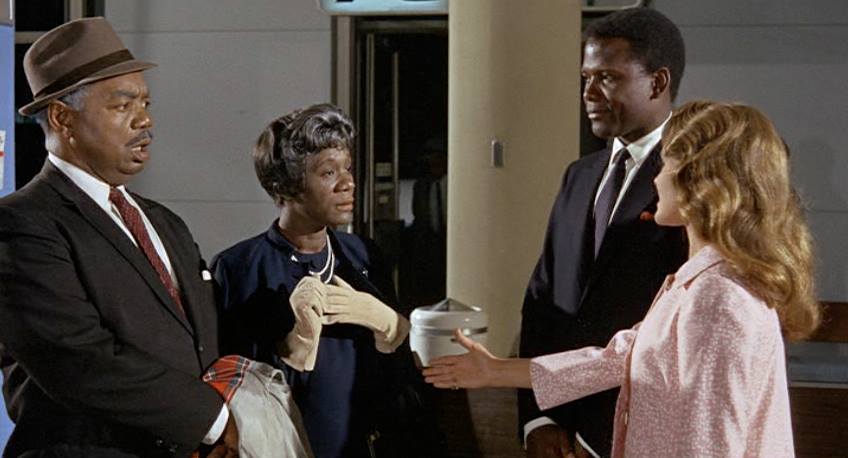by Ruth Goldman
Linked resource: Hegemonic Cinematography Exercise
Those of us who teach lighting know that skin tone greatly affects lighting choices. And those of us who have been teaching media production since the pre-digital age also know that capturing nuances of skin tone has gotten much easier over the past ten or so years. But many filmmakers and aspiring filmmakers don’t fully understand the backstory behind what we often understand to be straightforward technical and aesthetic choices.
 Over the past ten years I’ve frequently screened the 1967 film Guess Who’s Coming to Dinner in my film analysis classes, often at the behest of my students. The second or third time I watched the film on a larger screen I noticed something peculiar: the Black characters and the white characters are lit using a completely different aesthetic. Differences in skin tone are barely distinguishable between the Black actors, hotspots are often visible in their shots, and there are few nuances in the ways they are lit. In fact, once I started pulling stills and comparing the characters side by side, it was obvious that in the majority of the shots featuring Black actors, overexposure seemed to be the aesthetic.
Over the past ten years I’ve frequently screened the 1967 film Guess Who’s Coming to Dinner in my film analysis classes, often at the behest of my students. The second or third time I watched the film on a larger screen I noticed something peculiar: the Black characters and the white characters are lit using a completely different aesthetic. Differences in skin tone are barely distinguishable between the Black actors, hotspots are often visible in their shots, and there are few nuances in the ways they are lit. In fact, once I started pulling stills and comparing the characters side by side, it was obvious that in the majority of the shots featuring Black actors, overexposure seemed to be the aesthetic.
As Washington Post film critic Ann Hornaday explains, this was typical for the times: “For the first hundred years of cinema, when images were captured on celluloid and processed photochemically, disregard for black skin and its subtle shadings was inscribed in the technology itself, from how film-stock emulsions and light meters were calibrated, to the models used as standards for adjusting color and tone.”
In other words, film technologies were developed to effectively capture shades of white: the skin color that dominated the Hollywood film screen. In the past ten or so years, we have seen a complete reversal of this aesthetic. Films like 12 Years a Slave, Selma, Moonlight, Pariah, and Black Panther – to name just a few – have revolutionized not only cinematic representations of Black and darker skin tones, but cinematography altogether.
These indisputable facts offer a wonderful teaching opportunity and an effective way to blend theory and practice in teaching inclusive cinematography. Here’s how I do it:
I lead students through the Hegemonic Cinematography Exercise in one class, taking special care to discuss why camera department professionals would have made choices that now seem biased and why contemporary films look so different. We watch a scene from Guess Who and a scene from a contemporary film directed by a person of color and featuring a large cast of people of color. This naturally leads to some interesting discussions of our unconscious biases as well as the ways in which lighting and other aspects of cinematography help shape our understanding of film characters overall.
 Then, during the following class we practice lighting different skin tones, noticing what happens when we use the same lighting scheme for a variety of skin tones as opposed to creating a lighting skin tailored to an individual skin tone. In each case, I have the students frame a subjective shot and an objective shot, and ask them how they feel about the character(s) they’re seeing. We build from lighting a single skin tone to lighting different skin tones side by side and discuss how we overcome challenges in over and under exposing different skin tones.
Then, during the following class we practice lighting different skin tones, noticing what happens when we use the same lighting scheme for a variety of skin tones as opposed to creating a lighting skin tailored to an individual skin tone. In each case, I have the students frame a subjective shot and an objective shot, and ask them how they feel about the character(s) they’re seeing. We build from lighting a single skin tone to lighting different skin tones side by side and discuss how we overcome challenges in over and under exposing different skin tones.
Since cross-keying is such a common lighting solution, I use it to show students what happens when you cross-key with a generic lighting setup compared to adding separate keys and fills for talent with different skin tones. A cross-keying demonstration is a great example for showing how the same lights affect different skin tones in different ways.
My experience has been that students really appreciate learning about the invisible histories and politics of the technologies they take for granted and it helps them understand why inclusive practices in media production are so important.
References:
Xavier Harding, “Keeping ‘Insecure’ Lit: HBO cinematographer Ava Berkovsky on properly lighting black faces.” Mic (September 6, 2017)
Ann Hornaday, “‘12 Years a Slave,’ ‘Mother of George,’ and the aesthetic politics of filming black skin.” The Washington Post (October 17, 2013).
Nadia Latif, “It’s lit! How film finally learned how to light Black skin.” The Guardian (September 21, 2017).
Jen Yamato, “’Selma’s’ Bradford Young on the politics of lensing Black films.” Deadline (December 31, 2014).
Ruth Goldman is a filmmaker, activist, educator, and animal lover. She lives in Buffalo, NY where she is an assistant professor of Communication and the coordinator of Women & Gender Studies at SUNY Buffalo State.


